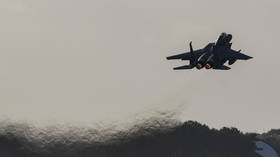Feds helpless in fight with drug cartel submarines

While the US ramps up its War on Drugs, dope smugglers are embracing state-of-the-art technology to elude authorities. At the top of that list are underwater submarines, and law enforcement agents say their usage is on the rise.
Diesel-powered submarines may be slow and hard to steer through the darkened depths of the waters surrounding the United States, but the stealth ships are being adopted more and more by drug traffickers who are constantly on the search for new tricks to bypass the ever increasing surveillance of routes relied on by smugglers to supply US dealers with their demands for narcotics.Although utilized as underwater drug mules for years, American authorities didn’t spot submarines as a an actual tool of traffickers until one 2006 attempt to move supplies into the United States ended with the Joint Interagency Task Force South, a Florida-based group focused on air and maritime drug smuggling activities, helping the US Coast Guard capture one of the ships. The feat was so celebrated at the time that the National Defense University acknowledged last year that it was still on display outside the JITFS headquarters. Today, however, submarine shipments of illegal drugs are on the rise and their increasingly common usage hasn’t been deterred by American efforts so far. Even with the War on Drugs relentlessly being allocated additional resources for what some have suggested is a battle already awarded to America’s enemies, a recent article published earlier this week in the New York Times suggests that these subs are posing problems for even well-financed sets of eyes.“These vessels are seaworthy enough that I have no doubt in my mind that if they had enough fuel, they could easily sail into a port in the United States,” Cmdr. Mark J. Fedor of the Coast Guard tells Times writers Michael S Schmidt and Thom Shanker in their collaboration piece, ‘To Smuggle More Drugs, Traffickers Go Under the Sea.”In their article, the authors add that these stealthy subs can cross upwards of 3,000 miles of ocean traffic undetected, only occasionally coming afloat for a brief breath of air before continuing on their journey. A journey, they say, which can carry 10 tons of cocaine from Ecuador to Los Angeles without ever being noticed. “American officials say they fear that the trafficking networks are moving away from so-called fast boats, the high-powered fishing and leisure boats that can carry about a ton of cocaine and are easier to spot, to semi-submersible and fully submersible vessels that can surreptitiously carry many more tons of drugs, which are unloaded in shallow waters or transported to shore by small boats,” they write for the Times.Steven Hoggard, the writer and director of a 2011 National Geographic Channel documentary that explored the Colombian drug trade, explained last year that these vehicles are being used more and more for their ability to go undetected for great lengths while transporting tremendous amounts of contraband."That's a far greater payload than a speedboat can transport and certainly more than a human drug mule can carry in their stomach,” Hoggard said.According to the Times’ piece, the biggest fault with this, however, is that — if detected — traffickers have a larger stash of drugs to be accountable for and, as a result, could land heavier sentences.Or, as the Times write, they can slowly dump their drugs and get off scot-free. In one instance included in the write-up, the authors recall an incident last September that left the US Coast Guard on a wild goose chase to catch a submarine in the Caribbean thought to be to the brim with cocaine. When the authorities ended their hunt 24 hours after they first set their sights on the sub, they were only able to salve two 66-pound bales of coke.“My staff watches multi-ton loads go by,” Rear Adm. Charles D. Michel of the Coast Guard tells the Times. He adds that drug interdictions this year are already up more than 50 percent from 2011’s figures, but for the surveillance of underwater ships requiring Americans to up their efforts on the air, land and sea, the US is seeing more and more shipments head towards America without intervention.The National Defense University’s 2011 report included in their analysis of the Joint Interagency Task Force–South found that traffickers may be using as many as 120 semisubmersibles each year, with the US Homeland Security Department speculating that around one-third of all cocaine in the US came off of submarines.














